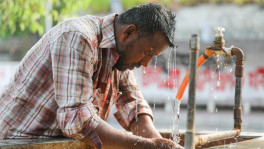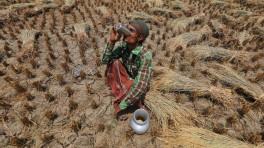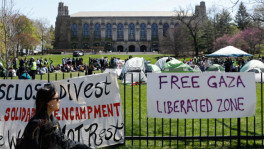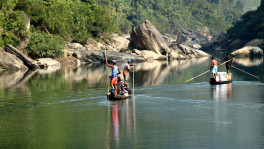134mm rainfall leaves city with death, waterlogging, stranded traffic

Water did not recede from a number of areas of Dhaka till Friday night after heavy rainfall flooded different areas of the city on Thursday.
Around 134mm of rainfall was recorded in Dhaka on Thursday, according to the Flood Forecasting and Warning Centre of the Bangladesh Water Development Board.
Among the areas where people suffered most for waterlogging were New Market, Bangshal, Jurain, Matuail, Mirpur-2, Dakshinkhan, Khilkhet, Ashkona.
The two city corporations of Dhaka, which are in charge of easing waterlogging in the city, said they have been working to remove water from the flooded areas, but the problem persists for long due to insufficient drainage system and plastics blocking the sewage system in some areas.
City planners said different organisations including the city corporations, Water Supply and Sewerage Authority, Rajdhani Unnayan Kartripakkha, Water Development Board are responsible for the waterlogging in Dhaka.
They also said waterlogging will increase day by day in the capital city due to filling reservoirs, encroaching into canals, and not developing the drainage systems. It is possible to reduce waterlogging with some initiatives, but it is not possible to get rid of the problem completely.
Professor Adil Mohammed Khan, executive director of the Institute for Planning and Development, told TBS, "Most of our reservoirs vanished in the last few years. The ponds were filled. We have no simple link between the canals, lakes, and drains. Local drains in particular are narrow and mostly filled with waste, hampering rainwater drainage.
"To solve the problem, the box culverts of Dhaka should be broken down with a resolute plan and the canals should be fixed. Besides, the canals and dams should be cleaned every year to facilitate the water flow."
The urban planner also said even if the drainage system is improved, it is not possible to reduce the waterlogging in Dhaka by more than 25%, because the city is developed in an unplanned way.
"The city dwellers are also responsible for this. They are filling the drains with waste. Besides, they narrow the space for drainage systems and roads while building houses," he added.
After Thursday's rain, the Dhaka North City Corporation said 10 quick-response teams were working to resolve the waterlogging in the area. The officials of Dhaka South City Corporation could not give any information about their work to ease waterlogging.
Maqbool Hossain Shimul, public relations officer of Dhaka North, told TBS that a quick-response team worked in each of the 10 regions of the city corporation. They could remove water from the Rokeya Sarani, and Banani road by 11am on Friday, and from the other main roads by noon.
However, there is still water in the streets of some areas – especially the newly added wards – due to the poor drainage systems there, said Maqbool.
Dhaka South City Executive Engineer Saiful Islam told TBS, "I am in charge of Khilgaon area. I sent people there in the morning but I did not see any water accumulation. Areas where water has accumulated are not under my jurisdiction."
Babar Ali Mir, regional executive officer of region-3 of Dhaka South, told TBS that there was no waterlogging in his area – Azimpur.
Newmarket, regional executive officer (zone-1) of Nilkhet area, Mohammad Shafiqul Islam refused to comment regarding the matter.
Azimpur and Nilkhet were among the most waterlogged areas since the rain on Thursday night, said sources.
Md Abu Nasser, spokesperson of the Dhaka South City Corporation, told TBS, "I have not been given any information about waterlogging. I called the officials concerned myself, but could not reach them."
A night of horror for Dhaka residents
Dhaka residents experienced a night of horror as the city witnessed 113mm of rain within only three hours, from 9pm to 12am on Thursday (21 September).
"I had to wait two and a half hours to get a vehicle in front of my office and was able to reach home at 2am," Yasmin Sultana, an employee of a private company, told TBS.
"There was waist-deep water in the Badda area, but I managed to get a CNG autorickshaw after waiting till 11:30pm," she said.
Many people could not find any vehicle to return home at night and waited on the roads. The very few vehicles available on the road overcharged passengers fares that were three to four times higher than normal.
"I left the office around 9pm when the road in front of the office was already underwater. I got on a rickshaw but got stuck in the Moghbazar signal for half an hour. After reaching Noyatola and Modhubag, the situation worsened. The roads there were completely inundated," said Sharmin Akhter, employee of a private company.
"The number of vehicles that went kaput on the roads was higher than the ones moving. It took me two hours to reach home in Rampura. I paid Tk300 for a rickshaw ride for which I usually pay Tk80," she added.
Sheikh Sabbir, another person waiting on the road at 10:45pm on Thursday, said, "There was 1 to 2 feet of water in places in Shantinagar. A number of cars, CNG autorickshaws and microbuses broke down on the road and caused a huge traffic congestion."
The excessive rain water flooded roadside shops. Shopkeepers at Elephant Road were seen removing the accumulated water out using buckets till late night.
Many people missed their buses and trains for planned trips ahead of the weekend. Some others could not even reach home and decided to stay at the house of someone they knew.
Social media were flooded with posts created by people stuck in traffic jams.
However, traffic congestion was the least of people's woes as four people, including three of a family, died after being electrocuted from a live wire in the accumulated rainwater on the road.
Residents of the city mourned the dead while questioning how safe the city was. One Facebook user wrote, "What has this city come to? Anyone could die any moment here."
Dhaka South City Mayor Fazle Noor Taposh said earlier this year that a target has been set to drain the rainwater in Dhaka South area within 15 minutes in this monsoon season.
Water pumps installed throughout the city to drain the water in times like these did not come to much use.
Mentioning that five pumps were operational in Kalyanpur to alleviate waterlogging in Dhaka North, pump operator Masum told TBS, "The water level at the pump area rose to 5.1 metres, surpassing the danger level. If the heavy rainfall continues, the task of pumping the water will be challenging."
Meteorologist Dr Muhammad Abul Kalam Mallick told TBS that no rainfall was recorded in Dhaka from 12:00am to 12:00pm on Friday. However, the intensity of rainfall may increase in the next few days.
He said rain is likely in most places of Rajshahi, Rangpur, Mymensingh, and Sylhet divisions.
It will rain for the next three days, and the amount is likely to increase, he continued.
He also said the amount of rainfall will likely increase in almost all parts of the country, including Dhaka, from 28 September.
The weather forecast for Dhaka and surrounding areas given by the Meteorological Department at 7pm on Friday said rain or thundershowers may occur in Dhaka. Around 2mm of rain was recorded in Dhaka from 1pm to 7pm on Friday.
Another forecast of the Meteorological Department at 6pm yesterday said light to moderate rain and thundershowers with gusty winds may occur in most places of Rangpur, Rajshahi, Mymensingh and Sylhet divisions and many places of Dhaka, Khulna, Barisal and Chattogram divisions. Also, moderate to very heavy rainfall may occur at some places across the country.
The maximum rainfall recorded in the last 24 hours till 6pm on Friday was 149 mm at Dimla in Rangpur, and the second highest was recorded in Dhaka at 116 mm.


 Keep updated, follow The Business Standard's Google news channel
Keep updated, follow The Business Standard's Google news channel
















